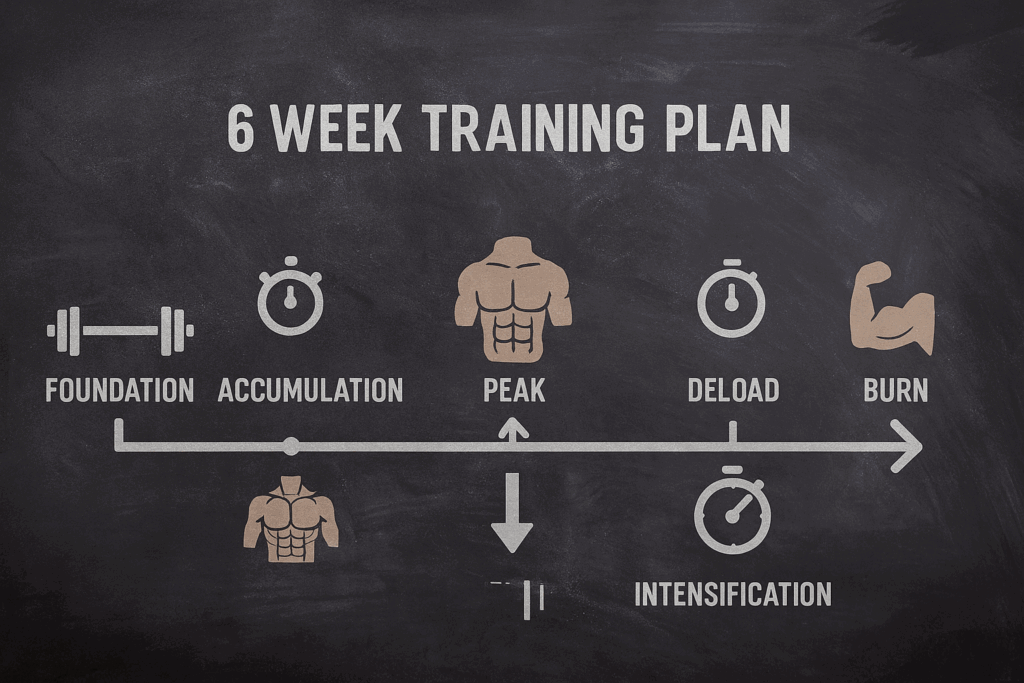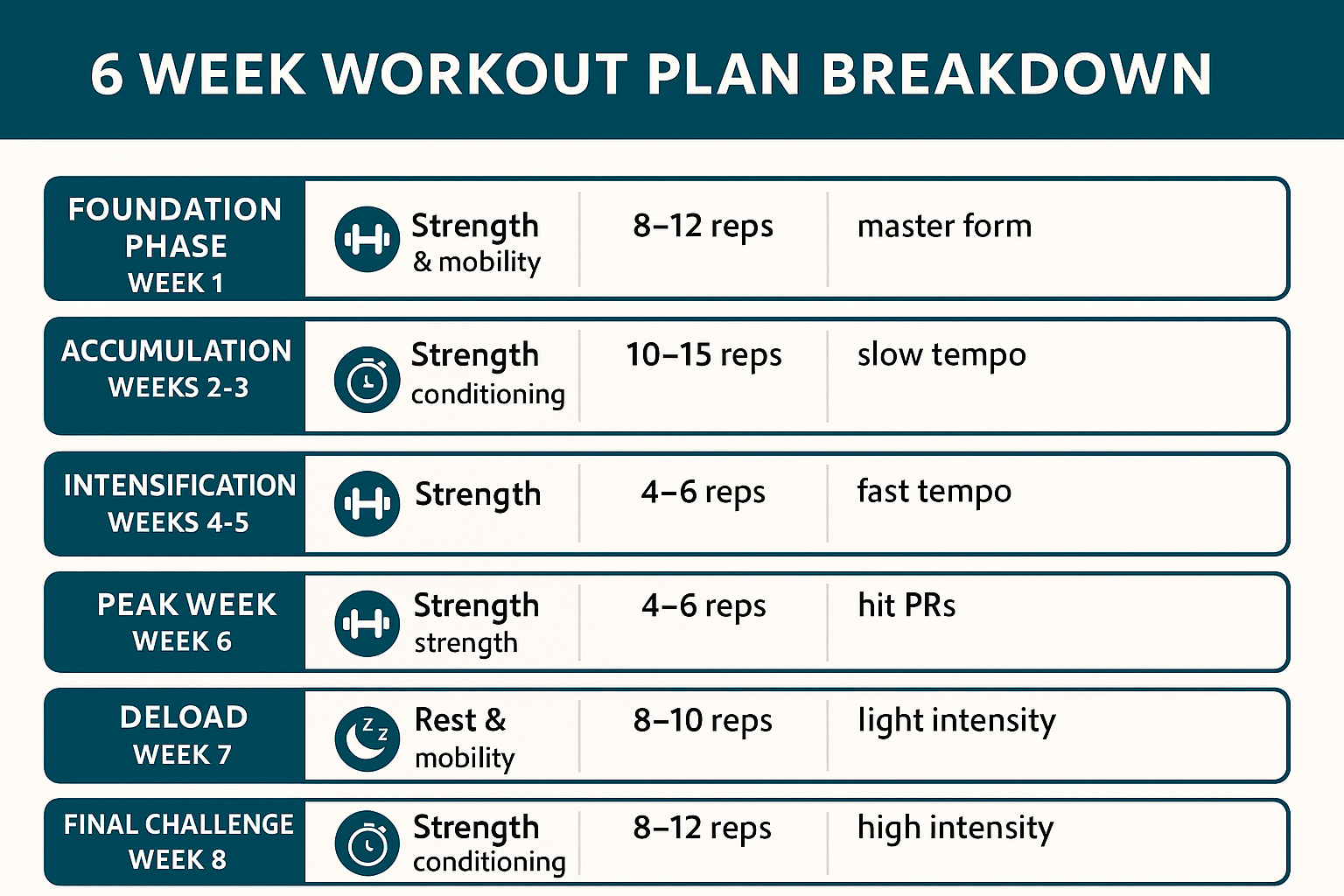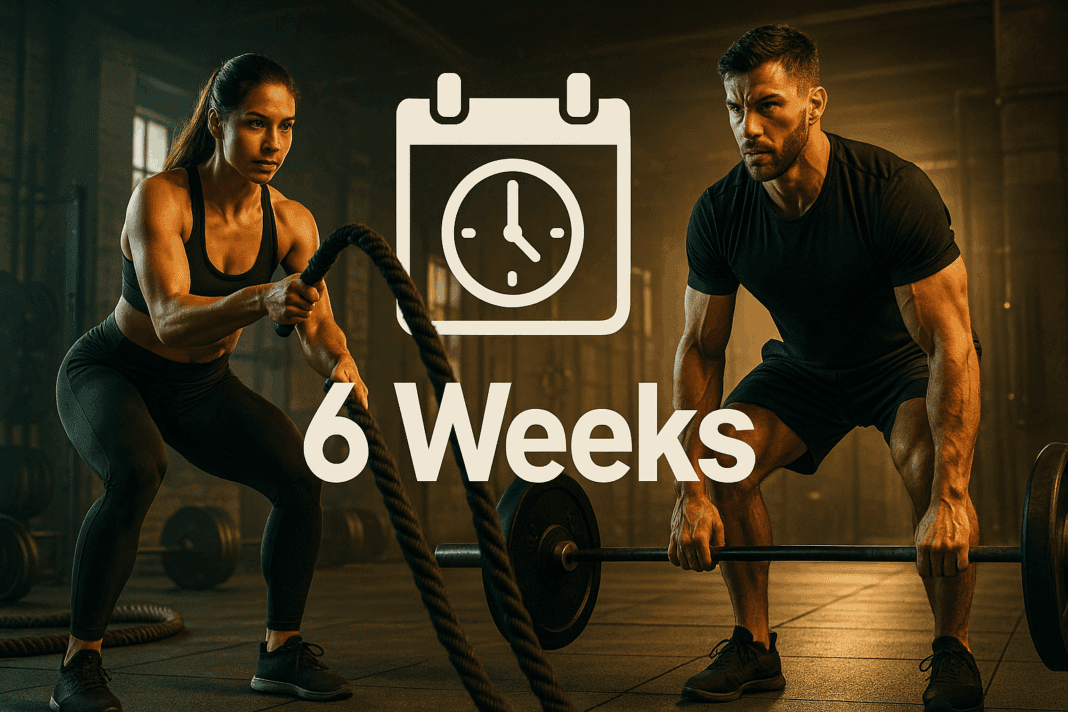Introduction: Why a 6 Week Training Plan Works
For anyone seeking to ignite physical change, a well-structured 6 week training plan offers the ideal combination of structure, urgency, and progression. This specific time frame is long enough to establish meaningful habits and drive significant physiological adaptations, yet short enough to maintain motivation and focus. By integrating strength training, conditioning, mobility, and nutritional structure, a 6 week training plan can serve as a powerful vehicle for total body transformation. For many, this serves not just as a workout calendar, but as a catalyst for rethinking their relationship with training, health, and discipline. In the paragraphs that follow, we’ll break down the science and strategy behind each week, equipping you with the knowledge and momentum to fully commit to a 6 week fitness plan built to optimize strength, burn fat, and radically enhance physical performance.
You may also like: The Ultimate 30-Day Workout Plan for Men Working Out in the Gym: Proven Full Body Strength Exercises to Maximize Results
The Anatomy of a 6 Week Training Plan: Structure and Periodization
A successful 6 week workout plan men and women can rely on hinges upon intelligent design. Periodization—the strategic manipulation of training variables over time—is central to achieving consistent progress while minimizing the risk of overtraining. Week 1 begins with a foundation phase: moderate volume, emphasis on form, and integration of mobility. Week 2 continues to build capacity while introducing slightly heavier loads or increased time-under-tension. Week 3 serves as a peak of early intensity, followed by a slight deload or volume reduction in Week 4 to facilitate supercompensation.
In Weeks 5 and 6, intensity climbs again, with performance-focused protocols and metabolic stress techniques used to maximize fat oxidation and strength gains. The six week workout program integrates strength-focused compound lifts, hypertrophy-specific accessories, and metabolic conditioning circuits for a complete, holistic approach. Whether you follow a full-body split, push-pull-leg format, or upper-lower rotation, the goal is to ensure muscle groups are worked thoroughly with sufficient rest and recovery windows. A successful six week workout plan isn’t random—it’s rhythmic, calculated, and progressive.

Strength Foundations: Building the Core of the 6 Week Workout Plan
In any effective 6 week strength training program, foundational lifts like squats, deadlifts, presses, and rows form the backbone. These compound exercises allow for progressive overload, stimulate multiple muscle groups, and create significant hormonal responses—especially testosterone and growth hormone release. For beginners and intermediates, mastering these movements ensures long-term safety and efficiency. Proper form, range of motion, and breathing mechanics must be prioritized over the amount of weight lifted.
The early weeks focus on developing neuromuscular coordination through moderate reps (8-10) and controlled eccentric tempos. As the plan progresses, lower rep ranges (4-6) are integrated to build maximal strength, paired with explosive tempo work to train power output. Supplementary exercises such as lunges, hip thrusts, incline presses, and chin-ups reinforce weak links and provide volume without overburdening the central nervous system. Each session should include a mobility warm-up, a primary lift, one or two accessory strength movements, and a brief metabolic finisher. The structure of this 6 week workout schedule helps develop raw strength while preserving balance and joint health.

Metabolic Conditioning: Burning Fat Without Losing Muscle
An effective 6 week fitness plan does not neglect the importance of fat loss. However, this must be achieved without compromising muscle tissue, especially for those following a 6 week workout plan men often adopt to reveal hard-earned muscle definition. Metabolic conditioning (“metcon”) combines resistance and cardio to spike heart rate, promote fat burning, and build work capacity. These circuits might include kettlebell swings, sled pushes, jump squats, battle ropes, burpees, or dumbbell thrusters performed in succession with minimal rest.
These sessions are usually placed at the end of strength workouts or reserved for separate training days. Timing matters—short, intense sessions lasting 20-30 minutes are often more effective for body composition than prolonged moderate cardio. As your body becomes more metabolically efficient, you’ll burn more calories at rest while preserving lean mass. The synergy between strength training and metabolic conditioning is central to the transformative power of any six week fitness program.

Cardiovascular Support: Where Low-Intensity Fits In
While high-intensity training garners most of the spotlight, low-intensity steady-state cardio (LISS) is a secret weapon in the 6 week workout routine. Activities like brisk walking, cycling, or incline treadmill sessions performed at 60-70% max heart rate aid recovery, enhance blood flow, and accelerate fat metabolism. LISS is best done in the mornings or on active recovery days.
This form of cardio is joint-friendly and sustainable, particularly important for beginners or those with orthopedic limitations. Including 2-3 sessions of 30-45 minutes weekly helps to round out your six week exercise plan without burning out your nervous system. Importantly, LISS doesn’t impair strength performance like frequent HIIT might, making it a valuable component of the overall 6 week workout program. Used wisely, it reinforces energy balance, promotes longevity, and supports the aesthetic goals of the plan.

Nutrition Synergy: Fueling the 6 Week Transformation
Training without proper nutrition is like firing a cannon from a canoe—it’s an unstable effort with poor results. A complete 6 week fitness plan includes a personalized nutrition framework to support strength gains and fat loss. Caloric intake should align with the goal: slight surplus for those seeking muscle gain, slight deficit for those aiming to burn fat. Protein remains the cornerstone—1.6 to 2.2 grams per kilogram of bodyweight helps preserve and build muscle.
Complex carbohydrates fuel performance: sweet potatoes, oats, rice, legumes, and whole grains offer sustained energy. Dietary fat from sources like avocado, nuts, olive oil, and fatty fish supports hormone balance and cellular health. Hydration plays a critical role in workout performance and recovery. Additionally, meal timing (e.g., pre- and post-workout nutrition) can enhance training output and muscle repair. A six week fitness plan paired with strategic eating creates the perfect metabolic storm for visible and sustainable transformation.

Recovery and Regeneration: Hidden Pillars of Progress
Behind every successful six week workout program lies a recovery plan that rivals the training itself in importance. Muscle tissue does not grow in the gym—it grows during recovery. Without adequate rest, the stress imposed by a 6 week strength training program can lead to fatigue, poor sleep, hormonal imbalances, and plateaus. Sleep (7-9 hours), rest days, active recovery (yoga, stretching, mobility drills), and parasympathetic practices (meditation, breathwork) are all vital.
Supplementation can support recovery. Magnesium, zinc, omega-3s, creatine, and adaptogens like ashwagandha or rhodiola help manage inflammation, promote repair, and buffer cortisol. Tracking recovery metrics using HRV monitors or simple mood/soreness scales adds further insight. In a six week workout plan men often overlook these aspects in favor of volume. Yet it is recovery that allows intensity and performance to flourish.

The Psychology of the 6 Week Commitment
Staying committed to a six week fitness plan requires more than physical preparation—it demands psychological resilience. The human brain thrives on structured goals, and six weeks is an ideal timeframe to see tangible results while maintaining focus. Setting clear, intrinsic goals (“I want to feel stronger and more energized” vs. “I want six-pack abs”) keeps motivation rooted in value and sustainability.
Journaling progress, visualizing success, and tracking victories beyond the scale (e.g., more reps, better sleep, improved posture) help reinforce momentum. External accountability—training partners, coaches, digital check-ins—adds a layer of commitment. Motivation may fluctuate, but discipline must remain steady. Each time you complete a challenging session or resist skipping a workout, you’re laying a psychological foundation for long-term success beyond the six week workout plan.
Customizing the 6 Week Workout Routine to Your Life
No plan is universally perfect. A truly effective six week fitness program must adapt to your individual context—work schedule, travel, injury history, stress levels, and access to equipment. This doesn’t mean compromising results; rather, it means optimizing consistency. If you have just 3 days per week, use full-body splits. If you train at home, prioritize bodyweight and dumbbell movements.
For those balancing high stress or shift work, lower volume and more restorative modalities may be beneficial. The key is adaptability. The best six week workout schedule is the one you can follow with intensity and consistency. Fitness is not about perfection—it’s about building momentum and navigating obstacles intelligently. Adaptation ensures adherence, and adherence ensures transformation.
Week-by-Week Breakdown of the 6 Week Workout Plan
Week 1: Foundation Phase
Goals: Establish movement patterns, increase mobility, develop baseline capacity
Reps: Moderate (8-10), Tempo: Controlled, Rest: 60-90s
Focus: Form, core control, mobility integration
Week 2: Accumulation Phase
Goals: Build volume, increase time under tension, reinforce consistency
Reps: 10-12, Supersets introduced, Focus on mechanical tension
Week 3: Strength Threshold
Goals: Increase intensity, lower reps (4-6), Introduce heavier compound lifts
Techniques: Rest-pause, tempo negatives, loaded carries
Week 4: Deload & Restoration
Goals: Reduce volume and intensity, prioritize recovery and joint health
Reps: Moderate (10-12), Mobility-focused circuits, breathing work
Week 5: Intensification
Goals: Peak performance, train at near-maximal effort
Reps: Low (3-5), Conditioning: EMOMs, short HIIT circuits
Week 6: Burn & Sculpt
Goals: Maximize fat burn, reinforce all adaptations
Workouts: Complexes, drop sets, high-rep finishers, LISS added

Frequently Asked Questions: The Ultimate 6 Week Training Plan to Build Strength, Burn Fat, and Transform Your Body
1. What Makes a 6 Week Training Plan More Effective Than Longer or Shorter Programs?
A 6 week training plan is optimal for creating results without overwhelming commitment fatigue. Unlike shorter programs that may not allow enough time for adaptation, or longer plans that can lose structure or interest, six weeks strikes a perfect balance. It’s long enough to instill habits, produce visible results, and map progressive overload, yet short enough to feel achievable. This window also suits the body’s natural adaptation cycles, especially when training stress and recovery are well managed. With clear start and end goals, a 6 week fitness plan becomes a measurable journey toward transformation.
2. How Can I Track Progress During a 6 Week Workout Plan Without Obsessing Over the Scale?
Relying solely on the scale can be misleading, especially when muscle gain offsets fat loss. Instead, track progress using strength benchmarks, circumference measurements, and weekly progress photos. Improvements in energy levels, endurance, sleep quality, and clothing fit also provide valuable feedback. Journaling your training consistency and perceived exertion is another non-scale metric of progress. This holistic view ensures that your 6 week strength training program supports both physical and mental improvements.
3. Should a 6 Week Workout Plan for Men Differ from One for Women?
While men and women share foundational movement patterns and recovery principles, subtle differences in hormonal response, muscle fiber distribution, and training goals may apply. A 6 week workout plan men follow might prioritize heavier compound lifts and upper body hypertrophy. In contrast, women may benefit from increased volume for glutes, core, and postural muscles. However, both sexes should focus on progressive overload, adequate protein intake, and proper recovery. Personalization within the six week workout program ensures results regardless of gender.
4. How Do I Adjust the 6 Week Training Plan for a Busy Schedule?
Consistency is more important than perfection. If your schedule only permits three sessions per week, shift to a full-body format that hits all major muscle groups with sufficient intensity. If you travel often, bodyweight circuits and resistance bands can be powerful substitutes. The key is maintaining adherence to your six week workout schedule with strategic modifications rather than abandoning the program. Remember, a 6 week workout routine should support your lifestyle—not conflict with it.
5. What If I Miss a Week During My Six Week Fitness Plan?
Missing a week doesn’t require starting over. Assess why the week was missed—was it due to illness, overtraining, or life circumstances? Then resume where you left off or insert a recovery week before restarting higher-intensity sessions. The adaptability of a six week fitness program lies in its structured progression and flexibility. Just ensure you resume with intent and avoid self-sabotage through guilt or all-or-nothing thinking.
6. How Does Nutrition Periodization Enhance the 6 Week Training Plan?
Nutritional periodization means adjusting caloric intake and macronutrient ratios in sync with your training demands. During high-intensity strength or hypertrophy weeks, slightly increase carbohydrates to support performance. In deload or recovery phases, reduce total calories while maintaining protein to aid muscle preservation. Aligning nutrition with the phases of your six week exercise plan optimizes fat loss, muscle gain, and energy balance. This dynamic approach reinforces your six week workout program with a metabolic advantage.
7. Are Supplements Necessary for a Six Week Workout Plan?
Supplements are optional, not essential. However, smart supplementation can support your 6 week fitness plan by improving recovery, performance, and nutritional adequacy. Creatine, whey protein, omega-3s, magnesium, and vitamin D are among the most researched and effective options. Choose supplements based on individual needs and dietary gaps rather than trendy marketing. A quality six week workout routine is always built on whole food, hydration, sleep, and consistency first.
8. Can I Use a 6 Week Workout Plan to Break Through a Plateau?
Absolutely. A plateau often results from lack of variation in stimulus or poor recovery. The structured progression in a six week training plan introduces new stimuli through changing reps, intensity, and exercise selection. Whether your goal is strength, fat loss, or endurance, the cyclical design of a 6 week workout program helps reignite progress. Add mobility work and recovery days to further enhance the effect.
9. How Do I Maintain My Results After Completing the 6 Week Workout Program?
Maintenance requires shifting from transformation mode to sustainability mode. Reduce training volume slightly while maintaining intensity. Reintroduce flexibility in nutrition while staying mindful of portion control and protein intake. Set new goals based on what you learned during the six week fitness program—whether it’s body recomposition, performance enhancement, or injury prevention. A well-executed 6 week workout plan should serve as a blueprint for ongoing growth.
10. What Psychological Benefits Can I Expect from a 6 Week Training Plan?
Beyond physical transformation, a 6 week training plan boosts self-efficacy, discipline, and mental resilience. Completing structured training builds identity as someone capable and committed. You’ll also likely experience better mood stability, increased focus, and reduced anxiety—especially if paired with mindfulness or journaling. The achievement of sticking to a six week workout schedule fosters a powerful mindset that can positively influence other areas of your life. Momentum gained over six weeks can shape long-term habits and redefine your self-image.
Final Thoughts: Sustaining the Momentum Beyond Six Weeks
Your six week workout program is not the end; it’s the ignition point. Once you’ve completed it, evaluate the process: What worked best? Where did you struggle? Use this insight to structure the next training phase, whether that’s shifting to hypertrophy, performance, or active recovery. Consistency beats intensity in the long run.
The strength you gain, fat you shed, and confidence you build are stepping stones—not final destinations. The true reward is the evolution of identity: from someone who “wants to change” to someone who “knows how to show up.” Let the structure of this six week workout plan guide you into a lifetime of strength, vitality, and autonomy.
You are not simply completing a challenge—you’re changing your physiology, psychology, and perspective. Six weeks. Full commitment. Transformational change.
Begin now.
Your best self is built one rep, one meal, one day at a time.





